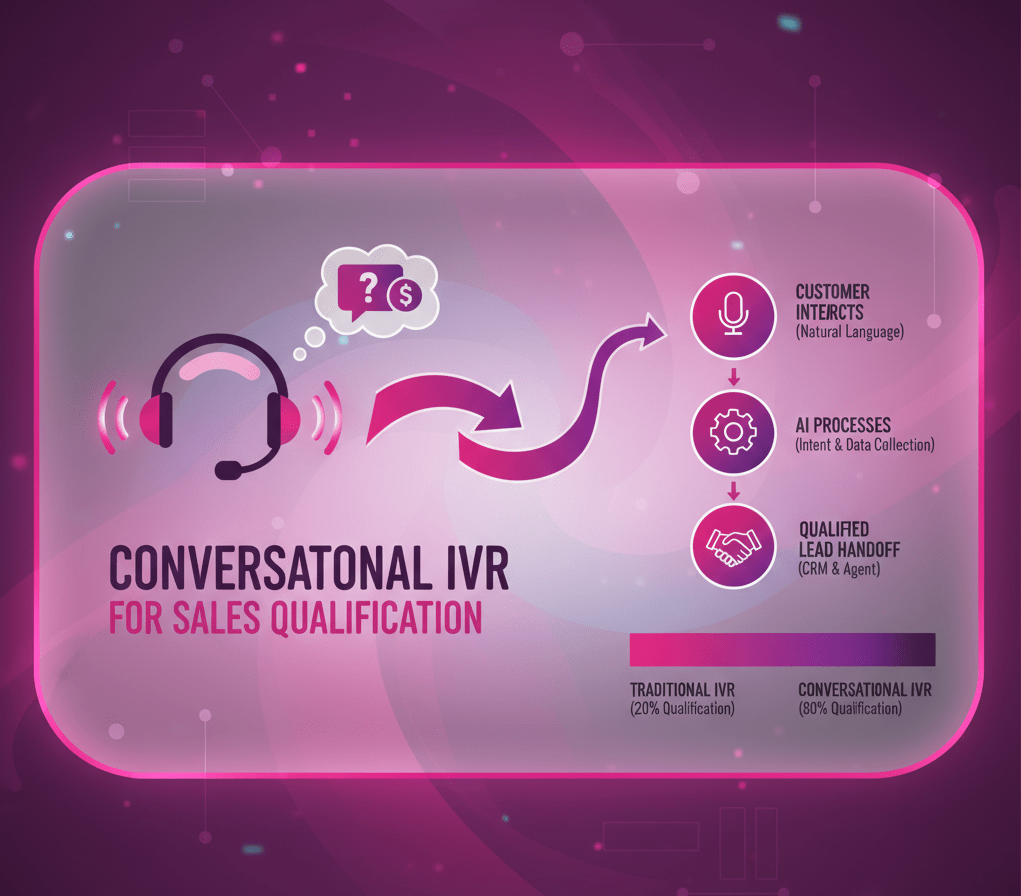“Implement a Conversational IVR for Sales Qualification to automate lead screening, eliminate button-pushing menus, and book meetings 24/7.”
“Thank you for calling. Please listen carefully as our menu options have recently changed.”
We’ve all heard it. We’ve all felt that familiar sigh of frustration. You’re a high-intent prospect, ready to talk, maybe even ready to buy. You’ve taken the proactive step of picking up the phone, a clear signal of serious interest in today’s digital-first world. And what’s your reward? A robotic, impersonal maze of “press 1 for sales, press 2 for support, press 3 to hear these options again.”
This isn’t just a minor annoyance; it’s a sales killer. That clunky, old-school Interactive Voice Response (IVR) system is the first point of contact for your most valuable inbound leads, and it’s actively pushing them away. Every second a potential customer spends navigating a rigid phone tree is a second they’re reconsidering their decision and inching closer to hanging up and calling your competitor.
But what if the first interaction wasn’t a roadblock? What if it were a conversation? Imagine a prospect calls and is immediately greeted by a warm, intelligent voice that asks, “Hi, thanks for calling. How can I help you today?” This prospect simply states their need in their own words, and the system understands. It doesn’t just route them; it engages, asks insightful questions, and determines if they’re a perfect fit for your sales team.
This is the power of a conversational IVR for sales qualification. It’s not just an update to an old technology; it’s a complete reimagining of how you handle your most valuable inbound leads. This article will break down precisely why traditional IVRs fail in a sales context and explore how modern conversational AI is transforming the front end of the sales process. Furthermore, we will see how platforms like SalesCloser.ai are taking this a step further, creating a fully automated engine that not only qualifies leads but also schedules them directly onto your sales team’s calendar, 24/7.
The Silent Revenue Killer: Why “Press 1 for Sales” is Obsolete
For decades, the traditional DTMF (Dual-Tone Multi-Frequency) IVR has been the gatekeeper for corporate phone lines. Its initial purpose was simple efficiency: sort callers into basic buckets to reduce the workload on human receptionists. For basic customer service inquiries, it was a tolerable, if clunky, solution. For inbound sales, however, it has become a catastrophic failure.
Friction is the Enemy of Conversion
Let’s be clear: a prospect who picks up the phone to call your business is a golden lead. They have bypassed email, chatbots, and web forms. They want to talk to a human being, and they want to do it now. Their intent is high, and their patience is low.
A traditional IVR introduces immediate, unnecessary friction into this critical journey.
- Rigid, Unintuitive Menus: The caller is forced to listen to a list of options that may not perfectly match their needs. What if they have a complex question that is part sales, part technical? Which button do they press? This indecision creates frustration and a feeling of being misunderstood from the very first second.
- The “IVR Jail” Loop: We’ve all been trapped in the endless loop of “Press 9 to return to the main menu.” For a motivated buyer, this is infuriating. It sends a clear message: “We don’t value your time, and our internal processes are more important than your needs.”
- Impersonal and Robotic Experience: The first impression of your brand is a cold, synthesized voice. It lacks empathy, understanding, and the ability to adapt. This impersonal greeting immediately devalues the human connection the caller was seeking, making your company feel distant and unapproachable.
The High Cost of Call Abandonment
The inevitable result of this friction is call abandonment. A study by Forrester revealed that poor IVR experiences are a major driver of customer frustration. While exact numbers vary by industry, it’s not uncommon for businesses to see call abandonment rates of 15-20% or even higher due to poorly designed IVR systems.
Now, think about that in a sales context. If 1 in 5 of your hottest, most motivated inbound leads are hanging up before they even speak to a person, how much potential revenue are you leaving on the table? These aren’t just missed calls; they are lost deals. The prospect isn’t just going to give up; they’re going to Google your competitor and call them instead. The company that provides the smoothest, fastest path to a solution is the one that wins the business.
A traditional IVR treats every caller the same, failing to recognize the urgency and value of a potential customer. It forces a high-intent buyer to jump through the same hoops as someone checking on a shipping status. This one-size-fits-all approach is a relic of a bygone era, and in the competitive landscape of 2025, it’s a critical liability for any sales-driven organization.
The Dawn of Intelligent Conversation: What is a Conversational IVR?
A conversational IVR represents a complete paradigm shift from its predecessor, which relied on press buttons. Instead of forcing callers into a rigid, predefined menu, it uses advanced artificial intelligence to understand and interact with them using natural, human-like language.
At its core, a conversational IVR is powered by several key technologies working in harmony:
- Speech-to-Text (STT): The system first converts the caller’s spoken words into written text. This is the initial step of understanding what is being said.
- Natural Language Processing (NLP): This is the brain of the operation. NLP is a field of AI that enables computers to read, understand, and interpret human language. It analyzes the grammar, syntax, semantics, and context of the transcribed text.
- Natural Language Understanding (NLU): A crucial subset of NLP, NLU focuses specifically on discerning the intent behind the words. It doesn’t just know you said, “I want to know about your enterprise pricing”; it understands you intend to inquire about purchasing a high-tier product. This is the difference between hearing and comprehending.
- Text-to-Speech (TTS): Once the AI has processed the request and formulated a response, a sophisticated TTS engine converts its text back into natural-sounding, human-like speech to continue the conversation.
From “Press 1” to “How Can I Help You?”
The difference in the caller experience is night and day.
Traditional IVR Interaction:
- IVR: “For Sales, press 1. For Support, press 2.”
- Caller: (Presses 1)
- IVR: “For new business, press 1. For existing accounts, press 2.”
- Caller: (Sighs, presses 1)
- IVR: “Please hold while we transfer you to the next available agent.”
Conversational IVR Interaction:
- IVR: “Hi, thanks for calling our company. How can I help you today?”
- Caller: “Yeah, I was on your website, and I’m interested in learning more about your enterprise software solution.”
- IVR: “Excellent! I can definitely help you with that. To make sure I get you to the right person, could I ask you a couple of quick questions?”
This second example is not a futuristic dream; it’s the reality of modern IVR solutions. The system immediately understood the caller’s intent (“learn about enterprise software”) and smoothly transitioned into the next logical step: qualification. The caller feels heard, understood, and confident that they are on a fast track to getting the information they need. There are no wrong buttons to press, no confusing menus to navigate. It’s a simple, elegant, and efficient conversation.
This ability to understand open-ended, natural language is what makes a conversational IVR an indispensable tool for front-end sales automation. It can begin the crucial process of qualifying the lead from the very first utterance.
Transforming Your Phone Line into a Sales Qualification Engine
A brilliant voice response system does more than just understand intent and route calls; it also provides personalized assistance. Its most excellent value for a sales organization is its ability to actively pre-qualify inbound callers before they ever reach a human sales representative.
By programming the AI with your specific qualification criteria—whether it’s BANT, MEDDIC, or a custom framework—you can turn your phone line into a consistent, data-driven qualification tool that works 24/7. Here’s how it works in practice.
Step 1: Instant Intent Recognition and Triage
The moment a caller states their purpose, the conversational IVR gets to work. It instantly differentiates between a sales inquiry, a customer support request, a partner query, or a job applicant.
- Sales Lead: “I need a quote for 100 licenses.” -> The AI flags this as a high-intent sales call and initiates the qualification script.
- Support Issue: “I’m having trouble logging into my account.” -> The AI understands this is a support issue and can route them to the correct queue or even help them with basic troubleshooting, freeing up the sales line.
- Other: “I’m calling to follow up on my invoice.” -> The AI identifies this as an accounting issue and routes them accordingly.
This initial triage is itself a huge boost to efficiency. It ensures that your highly-paid sales reps are only spending their time talking to actual prospects, not misdirected callers.
Step 2: Engaging in Real-Time Qualification Dialogue
Once a caller is identified as a potential sales lead, the AI smoothly pivots into a qualification conversation. This isn’t a robotic interrogation; it’s a natural dialogue designed to gather key information.
Let’s use the classic BANT framework (Budget, Authority, Need, Timeline) as an example:
Need: The conversation naturally starts here, based on the caller’s initial statement. The AI can dig deeper to understand the pain point.
- Caller: “I’m looking for a new CRM for my sales team.”
- AI: “I can certainly help with that. Can you tell me a little more about the biggest challenges you’re facing with your current system or process?”
- Caller: “Well, our current CRM is clunky, and we’re having a hard time tracking our lead sources effectively.”
Timeline: The AI can gauge the urgency of the request.
- AI: “That sounds like a common challenge we help companies solve. What’s your ideal timeline for getting a new solution in place?”
- Caller: “We’re hoping to make a decision this quarter.”
Budget: This can be a delicate question, but the AI can be programmed to ask it tactfully.
- AI: “To make sure we’re looking at the right package for you, have you allocated a specific budget for this project?”
- Caller: “We’re looking at something around $25,000 for the year.”
Authority: The AI can determine if it’s speaking with a decision-maker.
- AI: “Great, that’s very helpful. And are you the primary person who will be making the final decision on this purchase?”
- Caller: “Yes, I am.”
In under a minute, the system has engaged in a natural conversation and captured four critical pieces of qualifying information. The lead isn’t just a “warm inbound call” anymore; it’s a vetted opportunity with Contex and insightxt.
Step 3: Intelligent Call Routing Based on Value
Now comes the final piece of the puzzle: what to do with this qualified lead. A conversational IVR enables sophisticated, intelligent call routing rules that extend far beyond basic round-robin assignments.
You can create rules based on any data point gathered during the conversation:
- Deal Size: If the caller mentions a budget over $50,000, route them directly to a senior Account Executive. If the cost is under $5,000, route them to an SDR or an inside sales team.
- Urgency: If the timeline is “this month,” mark the lead as high-priority and push it to the top of the queue.
- Product Interest: If they mention a specific product line, route them to the specialist for that product.
- Geography: Route the caller to the sales rep who manages their territory based on their area code or a direct question.
This ensures that your most valuable leads are getting to your best closers instantly, while the appropriate resources handle other inquiries. It maximizes the potential of every single call and aligns your sales resources with the opportunities that have the highest probability of closing.

The Ultimate Evolution: Meet SalesCloser.ai, The AI Sales Agent
A conversational IVR that can qualify and route leads is a massive leap forward. It drastically reduces wasted time, enhances the caller experience, and ensures sales representatives are speaking with the right people.
But what if you could take it one step further? What if the system could not only qualify the lead but also take the final, most crucial administrative step: booking the meeting?
This is where SalesCloser.ai comes into play. It represents the ultimate evolution of this technology, moving beyond an intelligent voice response system to become a fully functional AI sales agent. SalesCloser.ai handles the entire front-end process from “hello” to “meeting booked.”
Closing the Loop: From Qualification to Scheduled Demo
Here’s how the SalesCloser.ai workflow transforms your inbound phone line into a 24/7 automated sales development machine:
- Engage & Qualify: Just like a standard conversational IVR, SalesCloser.ai answers the call immediately and engages the prospect in a natural, human-like dialogue to understand their needs and run them through your custom qualification script.
- Access Calendars in Real-Time: Once the AI determines that the caller is a qualified lead based on your predefined criteria (e.g., having the budget, being a decision-maker, or having an urgent need), it triggers the next step. It securely integrates with your sales team’s Google or Microsoft calendars.
- Offer Available Times: The AI then seamlessly pivots the conversation. It might say, “Based on what you’ve told me, it sounds like you’d be a great fit for our platform. Our product specialist, Sarah, would be the best person to walk you through a detailed demo. She has some time available tomorrow at 10:00 AM or 2:00 PM Pacific. Would either of those times work for you?”
- Book the Meeting & Send Invites: The prospect simply agrees to a time. SalesCloser.ai then instantly creates the calendar event, populates it with all the necessary details (including call notes and qualification data from the conversation), and sends invites to both the prospect and your sales rep.
The sales representative hasn’t had to lift a finger. They didn’t have to answer the initial call, they didn’t have to qualify the lead, and they didn’t have to engage in the tedious back-and-forth of scheduling. They simply look at their calendar and set that a new, high-value, fully qualified demo has been added.
Why This is a True Game-Changer
This isn’t just an incremental improvement; it’s a fundamental change in how inbound sales are managed.
- Zero-Second Lead Response Time: The “speed to lead” debate is over. Your leads are engaged and qualified the moment they call, regardless of the time of day.
- Eliminates Administrative Overhead: Sales reps are hired to sell, not to schedule meetings. SalesCloser.ai automates the most time-consuming parts of inbound lead management, freeing up reps to focus on what they do best: building relationships and closing deals.
- Flawless Hand-Off: Every piece of information gathered during the qualification call is automatically logged and attached to the calendar event or pushed to your CRM. The sales rep walks into the demo with complete context, looking prepared and professional.
- Never Miss an Opportunity: What about the highly qualified prospect who calls at 8 PM on a Friday? With a traditional system, they’d hit voicemail, and you’d be lucky if they left a message. With SalesCloser.ai, they can have a whole qualification conversation and book a meeting for Monday morning, all without any human intervention. Your sales engine is never off.
By handling the entire process from initial contact to a booked meeting, SalesCloser.ai transforms a simple phone number into your most efficient and reliable sales development representative.
Unpacking the Value: IVR vs. Conversational AI vs. SalesCloser.ai
To fully grasp the progression of this technology, it’s helpful to compare the three tiers directly.
| Feature | Traditional IVR | Conversational IVR | SalesCloser.ai (AI Sales Agent) |
| Caller Input | DTMF (Press-button) only | Natural Language (Speech) | Natural Language (Speech) |
| Interaction Style | Rigid, menu-based | Dynamic, conversational | Dynamic, conversational, goal-oriented |
| Intent Recognition | None (Menu selection only) | Basic to advanced intent | Advanced intent and context analysis |
| Qualification Ability | None | Yes, can ask questions | Yes, deep and customizable |
| Primary Function | Basic call sorting | Intelligent routing | Full qualification & meeting scheduling |
| Caller Experience | Often frustrating | Smooth and efficient | Seamless and conclusive |
| Sales Team Impact | Filters some calls | Provides vetted, routed calls | Delivers booked meetings to calendars |
| Operational Hours | 24/7 (routing only) | 24/7 (routing only) | 24/7 (full qualification & scheduling) |
The progression is evident. We move from a system that simply sorts calls to one that understands them, and finally to one that acts on them. While a good conversational IVR for sales qualification is a significant step up, SalesCloser.ai represents the final, most valuable piece of the puzzle by automating the action that all sales teams ultimately want: booking a meeting with a qualified prospect.
Conclusion: Stop Routing, Start Converting
The inbound phone call is one of the most potent signals of buyer intent in the entire sales and marketing landscape. For too long, companies have put their most valuable leads through an outdated, frustrating, and impersonal automated experience that drives them away.
It’s time to stop thinking of your phone system as a switchboard and start thinking of it as a strategic asset.
A modern conversational IVR lays the foundation by replacing rigid menus with intelligent, natural language conversations. You can enhance the caller experience, understand intent, and route leads more effectively. This alone can have a significant impact, helping you reduce call abandonment and ensuring your sales team speaks with more of the right people.
However, the actual transformation comes when you automate the entire front-end process. Platforms like SalesCloser.ai take the promise of conversational AI to its logical conclusion. By not only qualifying leads but also scheduling them directly into a sales rep’s calendar, it eliminates friction, maximizes efficiency, and ensures that no high-intent lead ever slips through the cracks. It turns your phone line into an automated, 24/7 sales qualification and appointment-setting engine.
The question for your business is no longer if you should upgrade from a “press 1” system, but how far you want to take your sales automation. Do you want to route callers more intelligently, or would you like to welcome them with a conversation that ends with a booked meeting on your calendar? For companies serious about growth, the choice is clear.
Frequently Asked Questions (FAQs)
Q1: What exactly is a conversational IVR?
A conversational IVR (Interactive Voice Response) is an automated business phone system that utilizes artificial intelligence, specifically Natural Language Processing (NLP), to understand callers’ words in their own language. Instead of requiring callers to press buttons on their keypad (“press 1 for sales”), it allows them to speak naturally to explain their needs. The system then understands their intent and can engage in a human-like conversation to help them.
Q2: How is a conversational IVR different from a traditional IVR?
The key difference is the input method and intelligence. A traditional IVR relies on DTMF touch-tone inputs within a rigid, predefined menu. A conversational IVR uses natural language speech as the input. This makes the experience far more intuitive and flexible for the caller, allowing the system to handle a much broader and more complex range of requests.
Q3: What is Natural Language Understanding (NLU)?
Natural Language Understanding (NLU) is a specialized part of AI that focuses on reading comprehension. It’s the technology that allows the conversational IVR to go beyond simply transcribing words and actually understand the meaning and intent behind them. For example, NLU can tell that “I want to know your prices” and “How much does it cost?” are both sales inquiries with the intent to learn about pricing.
Q4: Can a conversational IVR effectively qualify leads?
Absolutely. A well-designed conversational IVR can be programmed with a company’s specific sales qualification criteria (like BANT or MEDDIC). It can then ask targeted, logical questions conversationally to gather critical information about a caller’s budget, authority, needs, and timeline. This data is then used to score the lead and route it appropriately.
Q5: Will my customers feel like they’re talking to a robot?
Modern AI has made incredible strides in Text-to-Speech (TTS) technology. The voices used by advanced systems like SalesCloser.ai are remarkably human-like, with natural intonation, pacing, and inflection. While the system is AI-driven, the experience is designed to be smooth, professional, and conversational, rather than jarringly robotic. The efficiency and speed often lead to a higher-quality experience than a poorly designed traditional IVR.
Q6: How does a system like SalesCloser.ai handle non-sales calls?
This is a core part of its function. The AI’s primary task is to comprehend the caller’s intent. If a caller says, “I’m having a problem with my bill” or “My software isn’t working,” the system immediately identifies this as a non-sales inquiry and can route it to the appropriate customer support or billing department, just as a human receptionist would. This ensures sales reps are never bothered with support calls.
Q7: What CRMs does SalesCloser.ai integrate with?
SalesCloser.ai is designed to integrate seamlessly with your existing tech stack. It typically integrates with major CRM platforms, such as Salesforce, HubSpot, and Zoho, among others. This allows the system to automatically log call details, qualification notes, and meeting information directly into your CRM, creating a seamless data flow and providing your sales team with rich context.
Q8: Is a conversational AI system complex to set up?
No. Modern solutions are typically cloud-based and designed for rapid implementation. The setup process normally involves defining your qualification criteria, creating the conversational script with the provider’s assistance, and connecting the system to your phone lines and calendars. A platform like SalesCloser.ai can often be up and running in a matter of days, not months.








